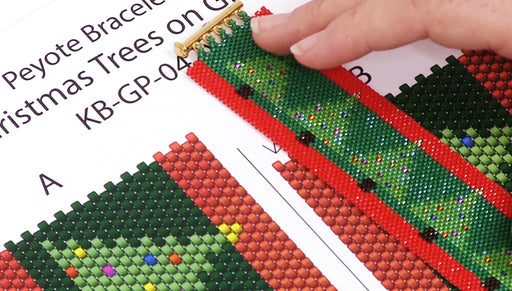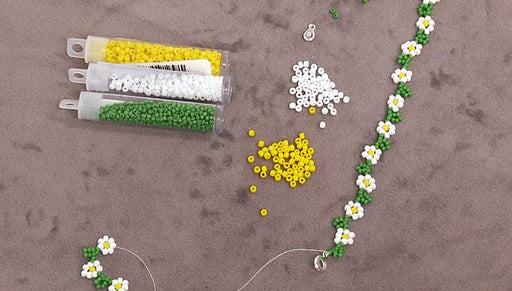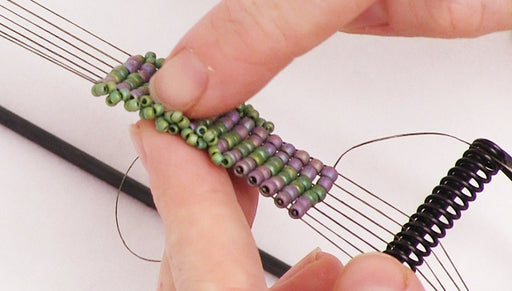
|
NYMO Nylon Beading Thread Size B for Delica Beads "Black" 72YD (66 Meters) SKU: XCR-8932 $2.79 |

|
Toho Bugle Tube Beads Size #1 / 2x3mm Opaque Turquoise 8 Grams SKU: JSB-0037 $1.99 |

|
Miyuki Delica Seed Beads, 10/0 Size, Matte Cream DBM0352 (8 Grams) SKU: DBM-0352 $5.85 |

|
Miyuki Delica Seed Beads, 15/0 Size, Matte Cream DBS352 (4 Grams) SKU: DBS-0352 $4.89 |

|
Miyuki Delica Seed Beads, 10/0 Size, Opaque Red DBM0723 (8 Grams) SKU: DBM-0723 $4.30 |

|
Miyuki Delica Seed Beads, 10/0 Size, Opaque Turquoise DBM0729 (8 Grams) SKU: DBM-0729 $3.90 |
Hi, this is Julie with beadaholique.com and then the fringe uses the same size beads which are ten oh my yuki delicas to do the main part of the fringe and then I've got a bugle bead here which is a nine millimeter and these little turning beads down here are 15a delicous so peyote and then the fringe and I've already created a piece of peyote that I'm going to add fringe to and I just did a striped pattern you can really do whatever pattern you want if you don't know how to make this piece here we do have other videos on beadaholique.com showing you how to do peyote stitch herringbone a lot of other bead weaving stitches that would work well for adding fringe to in terms of the supplies you're going to need well the sky is really the limit with fringe I like to use a lot of the beads I use already in my bead woven piece that I'm starting with so I'm going to use again my yuki ten o teleca's in the colors from my main piece for this particular piece of Fringe I've pulled some three millimeter bugles and then the 15 o beads you really can use whatever you want if you use the beads are the same size as in your main beadwork you'll see that they're all going to lay very nice and even together if you use larger beads they might end up kicking out the fringe a little bit because we're going to take up more space between the rows and if you use smaller ones you're just going to have longer gaps between each dangle I'm going to show you how to do this little zigzag pattern which is I think it's really fun in terms of the thread you're going to be using I strongly recommend using 9:04 a fridge I usually use fire line or wildfire for my bead weaving which is great and that's what I did here and it's nice because it's really stiff and strong so you see how solid that really is for a thread but na mo is a lot looser it's got a lot more give to it and a lot more movement and that's what we really want for the fringe we want it to be able to just dangle and move about and then you're going to need a needle and you're going to need a pair of scissors so I'm going to cut off a length of thread here and I'm just doing a sample swatch so I'm not doing a whole project here but you'd want to make sure that you have a length of thread that you're comfortable working with you can always add more later that's not a problem with fringe you don't feel like you have to start with as much as you're going to end up needing but I always say start with whatever length you're comfortable and I'm usually comfortable with about 4 feet or so I'm going to place a stopper bead on the end of my thread leaving a tail of about 6 inches I want to have that tail long enough that I can go back at the end and thread a needle back onto it and work my tail into my beadwork to begin you're going to want to take your needle with the stopper bead attached go through the first bead that you want your fringe to start from and come out in the same direction that you want your fringe to be hanging you'll see what we have here so I want my friends to be coming down this way so I'm exiting that bead and now I'm going to create my fringe I think the pattern I'm going to want from my fringe I like to lay out out my beads I think I'm going to want some of these little cream-colored ones followed by the blue followed by the red and then I think I'll add the bugles probably going to come back and do another little segment of red and then another little bugle and then my turning beads so I like to do this when I'm making fringe I like to set out my fringe pattern in front of me so I can just pick them up in a row so I'm going to start with one of my little cream beads I'll do one of each of these and go ahead and see what that looks like so it's not a very long fringe I think it's going to be pretty maybe what I'll do is I'm going to add two little red beads down there before that second bugle bead let's try that let's actually do two Reds the second bugle so that's what I've got now I'm going to pick up my turning beads you always are going to need a turning bead or beads it can be whatever you like I just happen to like these little guys and I've put three of them onto my needle and I'm going to pull them down so as the name suggests we're now going to turn so our turning beads become the N beads as you see in this little example here so now we want to go back up through at second bugle or whatever B you have as your n bead before you're turning beads and also go up through all the beads that are part of your fringe and that bead that you came out of as secured to your beadwork so that edge bead on your actual main piece of beadwork okay make sure those turning beads do what they're supposed to which is turn and you want to pull it tight so there's not a gap but not so tight that stiff this is what you don't want you don't want to stiff like that you want it loose and that's why we're using the NEEMO is also why I like to start with a starting bead bead stopper so that if my tension is too tight on this side after I've done all this beading down here I can loosen it up a little bit before I work in my tail and tie off that end of the thread so now we need to create our second row of fringe so we're going to just take our needle and go down through the second bead in our bead work along the edge pull that stopper bead out of the way so now we're exiting where we want to be exiting or and create our second row a fringe and we're going to start to create this exact pattern and to do that instead of doing an identical segment of Fringe we're going to add one more of these cream beads to start with and then we're going keep everything else the same and again your three turning beads now we're going to turn go back up through all our beadwork as well as that bead we came out of and check down here to make sure that your beads did turn properly sometimes they need a little bit of help there we go now we're just going to jump over to the next bead and we're going to repeat announce Ted of adding to here we're going to add three so we're adding just one more each time and back up through our line of fringe and back up through that bead that we started from so this is what we have so far and you can see that they're starting to be a bit of a zigzag appearing just a start of one side of it and I'm going to do a few more rows here on camera but there's not a lot of dialogue per se to tell you as I'm doing this we're just repeating the same action but adding one extra of these cream beads each time if you're doing this at home it doesn't have to be just the cream beads you could have created this exact down here you could have had more bugles fewer bugles bigger ones there's a lot of flexibility to be had with fringe but I'm going to do a few more here so you can really see this pattern start to develop this one here I'm going to add four of the cream beads and then the same pattern for the rest of them okay so this is what we have so far you can see we're really getting that diagonal look going and I'm going to start to do just one or two going up the opposite way so you can see how that looks and then I'm going to show you how to tie off your threads to be able to complete your fringe so let's just continue along and so you'll see I'm exiting the row but I want to do next and now I have can count these I've got seven of these cream beads so to start going up the opposite way we want to have one fewer so I'm going to do six alright so I've got six there on my needle and then the same pattern repeated I think it might be just a little bit easier to see what I'm doing if I lay this down on the table as I'm doing it so I'm just taking my needle again and going up through all those beads and the actual edge of the beadwork as well and you'll see they occasionally get this little loop right here and all you need to do to get rid of that is pull your beads down and then carefully pull your thread up it's not a knot it's just the fact that your stopper beads when they did the turn had more thread on the first part so the going down side there's a little gap of thread and then you turned your beads you went back up and so when you pulled it tight there's a little loop of thread there's not a knots not anything you have to undo you just have to work with it a little bit alright so I'm going to do one more and then I'm going to show you how to tie off the threads so I had six well first I had seven then I had six now I'm going to do five of these little cream beads that's six we don't want that okay there's five and we lay it down so hopefully a little easier to see all right there we go hopefully that pattern is starting to show all right so I was kind of fun pairing stripes with now a chevron type design now I'm going to show you how to go ahead and get rid of your threads so tie them off and incorporate them into your beadwork so this is the same method as if you're doing any other type of bead weaving you needed to tie off or add more thread so we're going to go ahead and work our needle into our beadwork and we don't want to pull too tight because remember we don't want that to be stiff that we don't want that fringe to be stiff now we're going to go down through our beadwork and then back up just a little bit over and through the loop we just made so we're going to be making a knot so what we're doing pull it tight so it disappears into the beadwork go a little further along so again work your needle up into your beadwork and the one thing with fringes it does tend to get caught when you're working with this so just be patient any direction you want to go if you have beadwork that really does show your thread path always make sure to just follow your thread path don't create a new one okay I'm going to another knot again just work my needle in you do that as many times as you really want to I find two to three knots is really sufficient and then you just go ahead and trim off your thread and then you would go back to this side remove that stopper bead rethread your needle onto your thread and do the exact same method let me lay this out for you so you can see what it looks like and that is how you make a beaded fringe you
Related Videos


How to Read a Peyote Pattern Bead Chart
In this video, you will learn how to read peyote patterns simply and easily. Update: The kit shown in this video is no longer available. We have in...
View full details

How to Make a Daisy Chain Bracelet
In this video learn how to bead weave a classic daisy chain bracelet. This project is quick and easy.


How to Add a Beaded Edge to Loom Work
A fun variation to traditional loom work, this video demonstrates how to add a ruffled beaded edge.
